Kariba Slaughter
by Frank Bate
Photographs by Francois Darquennes
THE photographs in this special 12-page news supplement are truly world-exclusive. They were taken by Francois Darquennes, a young French freelance photographer based in Salisbury. Minutes after hearing that an Air Rhodesia Viscount had gone down in the bush after take-off from Kariba. Darquennes was in his car and speeding towards the scene. He drove through the night — alone, unescorted and acutely aware of the ever- present possibility of a terrorist ambush - to reach the scene of the crash in Rhodesia's terrorist- infested Urungwe tribal trust land. Darquennes was the very first Pressman and photographer on the scene. He actually arrived before a group of international journalists who were flown specially from Salisbury to witness the aftermath of the atrocity that would soon stagger the world. By then it was all over. The pitiful remains of the victims had been removed and the bulk of the wreckage carted away or examination. Darquennes' graphic pictures are the world's only full record of the diabolical horror visited upon a group of stunned and innocent air crash victims
Our covering story - the first full, minute-by- minute account of the entire tragedy from start to finish — was written by SCOPE'S Executive Editor Frank Bate. Bate's story was compiled from an on-the-spot report by Salisbury-based journalist Karin Pretorius, interviews with the horror- stricken survivors and members of the security forces, plus a discussion with a former Viscount pilot and friend of Captain John Hood, the pilot of the doomed aircraft. Pieced together, they present the only comprehensive story of the last minutes of Flight RH 825 and the horror- filled hours that followed the crash.

An Act Of Disgusting Brutality
SUNDAY, September 3, (1978) 5.05 pm, Rhodesian time. Watched by heavily-armed members of the security forces, Air Rhodesia Viscount VP-WAS lifted off from Kariba Airport right on schedule.
Apart from a slight smoke haze on the ground, visibility was good as flight RH 825 climbed steeply at 160 knots on the way to its cruising height of 15 000 feet for the short routine hop to Salisbury.
On board were 52 passengers and four crew. Of the passengers on the Viscount 34 relaxed and happy holidaymakers men, women and children returning home - had less than 10 minutes to live.
Three of the crew would also die in flaming agony; the fourth - a lovely young air hostess - would live . . . only to be pack-raped, bayoneted and finally, and perhaps mercifully shot to death.
Seventeen other people would miraculously survive the first stage of the awful holocaust to come. But only eight would live to tell the full story of the horrendous aftermath, a story of unsurpassed, incomprehensible horror and bestiality that has shocked and stunned most of the civilised world.
IN the cockpit, Captain John Eric Courteney Hood, 36, set a heading of 160 degrees south- east as the aircraft sped along at three nautical miles a minute to its destination in Salisbury about 55 minutes away from take-off.
Rhodesian-born and educated at Allan Wilson Technical High School in Salisbury, Captain Hood had two daughters aged 10 and three by his first wife. Only recently, he had married for the second time.
Captain Hood was an extremely experienced pilot with about 8 000 flying hours in his logbook. Within the next few terrible minutes, all his years of experience and training, all his personal courage and daring, would be put to the ultimate test.
He would be called upon to land an aircraft blazing fiercely and breaking up in mid-air. He would have to do the impossible and. but for a cruel twist of fate, he would nearly succeed.
Also on the flight deck sat First Officer Garth George Beaumont, 31. Single, born in Florida in the Transvaal, but educated at Plumtree School in Matabeleland, he had joined Air Rhodesia in 1974 and was converted to Viscounts the same year. First Officer Beaumont, too, was a highly competent pilot who had notched up about 4 000 flying hours.
The type of aircraft the two men were flying is one of the most remarkable and reliable air- liners in service anywhere.
Powered by four Rolls-Royce Dart turbo-prop engines each delivering 1 600 horsepower, Viscounts were first delivered to what was then Central African Airways in 1956. During 22 years of non-stop service, they have become a legend to all who fly them. No other airline crews in the world are as experienced on Viscounts as Air Rhodesia staff.
For many of the people on board, a weekend at Kariba - Rhodesia's Riviera - was a chance to relax, to forget the daily grind of city life and put aside all thoughts of the bitter terror war which has already claimed more than 3 000 lives this year alone.
Air hostesses Brenda Pearson, 23, and Dulcie Esterhuizen, 21, walked down the aisle with a trolley of cocktails and sun-downers ordered before take-off. Some passengers chatter quietly to family and friends; others, exhausted after a hectic Kariba weekend, dozed peacefully in their seats; yet others gazed at the thick carpet of bush sliding below as the Viscount surged into the late afternoon sky.
SALISBURY tobacco farmer Tony Hill unclipped his seat belt and settled back as one of the pretty stewardesses poured him an ice-cold beer. Hill was feeling good. He had shrugged off the sudden, fleeting stab of uneasiness that had gripped him as he boarded the plane at Kariba ... the unaccountable twinge of apprehension that had made him choose a seat at the rear of the aircraft.
Now the feeling had gone, and Hill, who had been visiting friends at Kariba, turned his thoughts to Salisbury and home, where his wife Marcia and his daughters Brenda and Sonia would be waiting eagerly to greet him.
Tony Hill would have to endure hell on earth before he saw his family again.
In Salisbury, relatives and friends were preparing to drive out to Hatfield to meet the aircraft, which was scheduled to land at 6 pm. It never arrived.
ON the ground, about 20 miles from Kariba Airport, a shoulder-launched SAM-7 surface-to-air missile was primed ready to be fired.
Terrorists attached to Joshua Nkomo's Zimbabwe People's Revolutionary Army (ZIPRA) had set the weapon directly in line with the Viscount's flight path. They knew that Air Rhodesia sticks rigidly to its flight schedules. They knew that flight RH 825 would take off at 5:05 pm on Sunday, September 3. They also knew the aircraft would pass directly overhead. That was why they were there. Now they waited to blast it from the sky.
The Viscount was flying at between nine and 10 000 feet and still climbing when the Soviet-made warhead came streaking upwards on a cone of orange flame, homing in faster than the speed of sound on the heat from the aircraft's engine exhausts.
There was no escape, no evasive action Captain Hood could possibly have taken, even had he known what was about to strike. Once the missile rocketed from the launch tube, flight RH 825 was doomed.
With a blast that shook the entire aircraft, the missile tore into the inner starboard motor, causing a simultaneous explosive chain reaction in the outer engine as well.
FRIGHTENED passengers stared in dumbstruck horror as thick black smoke and long tongues of flame streamed past the cabin windows and chunks of debris spun away in the slipstream.
The aircraft shuddered like a mortally wounded bird, and at that moment Captain Hood and First Officer Beaumont, as well as most people on board, must have known that they were about to die. In the cabin, pandemonium broke out.
On the flight deck, all was calm but both men must have been bewildered by the suddenness with which disaster had struck. Years of constant training had equipped them to deal with any emergency likely to be encountered in the air, but no training manual yet devised lists the steps to be taken by an air- line pilot when his civilian aircraft is blasted by a heat-seeking missile. Neither Hood nor Beaumont could have had the slightest idea of what had really happened.
If the airflow over the wings and the forward position of the flight deck on a Viscount prevented Hood from seeing the flames billowing from the engines, the first warning he would have had of impending catastrophe was the flashing of amber warning lights and the strident clamour of bells on the instrument panel, indicating that engine numbers three and four were ablaze.
Fire in the air is a pilot's greatest nightmare, his constant over-riding fear.
Captain Hood knew that a Viscount can, in certain circumstances, fly comfortably on only two engines, But he must also have realised that to try to turn back to Kariba would have been fatal as he would have lost crucial airspeed in attempting the turn.
THE aircraft was in immediate danger of breaking apart in mid-air; it was a miracle that the fuel in the wing tanks had not already exploded and blown the ship to bits.
There was only one thing to do, one course of action to take: the Viscount had to be put down in the shortest possible time on the first stretch of open ground directly in its path.
All Captain Hood's experience and training must have told him that his was an impossible task. Yet he never gave up. The feelings of the two pilots will never be known. Both are dead. But one thing is certain, neither panicked for a moment; their conduct throughout was a credit to their profession.
"And look for somewhere — And look for somewhere."
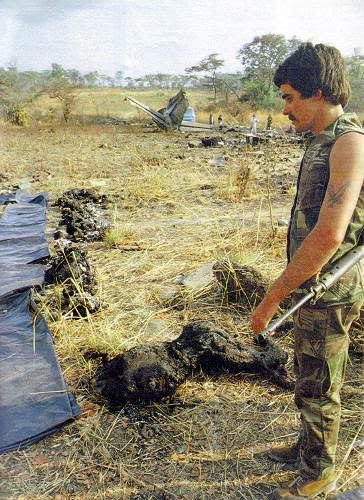
Satan's handiwork .. . grim-faced Rhodesian trooper stares in horror at the charred remains of passengers who died when an Air Rhodesia Viscount was brought down by a terrorist SAM-7 missile.
EVERYTHING was happening at once, yet Captain Hood still had the presence of mind during this critical time to not only radio a distress signal to Kariba flight control, but to reach down, change his transmission switch in public address and speak to his passengers as well.
At about 5,10 pm - only a scant five minutes after take-off and about 20 miles from the Kariba airstrip - Captain Hood transmitted his last message to the world out-side his maimed aircraft. Some of it was garbled, bul a National Parks Board pilot tunes into VP-WACs radio frequency picked up these words: "I can't . , . the engines are going like f . . , Help me? I have lost both starboard engines... Were going in."
Then Captain Hood switched to internal PA - still holding the aircraft in a steep dive and battling to keep it on an even keel — and spoke to his passengers. He instructed them lo fasten their seat belts, keep calm, and to place their heads in the "crash position" between their knees.
"We are going in for an emergency landing.
IN the main compartment passengers sat in stunned horror. Here and there a woman sobbed and screamed and some men milled around in panic-stricken confusion. Sheets ol flame shot past the windows, the intense heat searing the metal fuselage.
One man ran down the aisle shouting for a fire extinguisher, another tried to force open the emergency exit and jump out as the plane plummeted earthwards, its two engines wailing like banshees.
A Viscount normally lands at a speed of 95 knots, but airspeed must have built up way beyond that mark during the emergency descent. It was unavoidable. he aircraft had to be put down and the passengers evacuated within minutes.
Captain Hood decided to doa wheels-up belly landing on a roughly ploughed cotton field the size of two football pitches in the rocky foothills of the rugged Whamira Hills, about 50 miles due west of Karoi. Ironically, Whamira is Shona for "You can't go any further."
HE nearly made it," says Chief Inspector Mike Farrell, the Rhodesian police officer in command of the crash zone.
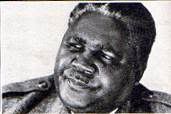
The Blood Of Innocents Is On His Hands

This is what your brave "Freedom Fighters" did Mr. Nkomo.
You must be very proud of them
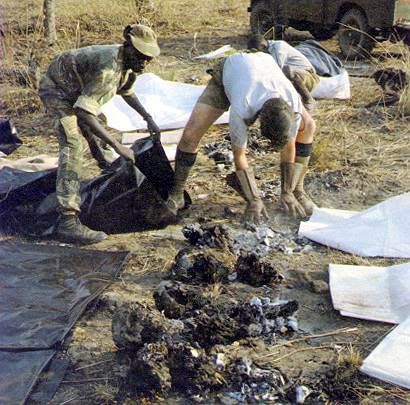
A terrible task A BSA policeman loads a fire blackened body into a plastic bag for later identification.
"He came in over those trees he adds, pointing to the edge of the clearing. "You can see where he took the tops off. It was quite a feat of flying to find this clear space, and we believe the plane was coming down well under control. If he hadn't hit the donga wall he might have pulled it off."
The field is split by a gully about 15 feet wide and 20 feet deep in parts, the earth bank freshly scarred where the aircraft slammed into it after skidding down the sloping field or its belly for about 100 yards.
THE whole area is littered with crash debris; chunks twisted scrap, fire blackened engines, a buckled propeller lying on the donga bank, pools of molten metal liquefied by the searing flames, the surrounding bush scorched by the bushfire sparked off by ruptured fuel tanks as the Viscount cart wheeled across the donga and exploded in a ball of fire.
Cameras, shoes, suitcases, a child's doll, a bloodstained petticoat, a tennis racket, charred playing cards, scraps of torn clothing ... all pathetic reminders of the awful human tragedy played out in this remote and lonely spot.
In the forward section of the cabin are the cinder-black corpses of some of the passengers and crew killed on impact, their bodies still doubled over in the crash position. Burnt limbs and carbonised skulls are scattered in heaps of ash, and the soft breeze still bears the bitter-sweet reek of charred flesh.
White-overalled aviation experts sift through the wreckage seeking to identify the cause of the disaster - at this early stage it was not known that the Viscount had been brought down by a missile — and BSA police- men wearing rubber gloves picks through the grisly debris for scraps of burnt flesh, arms, legs, skulls, mutilated and scorched bodies which they place in plastic bags. All the dead were taken to Salisbury tor identification.
The only recognisable section of the downed aircraft is the tail plane and the rear section of the fuselage which held the last five rows of seats. All 18 survivors were sitting there.
THEIRS was a truly miraculous escape from death. But when they stumbled from the wreckage, many of them torn and bleeding, all of them dazed and shocked, their ordeal had only just begun.
Only eight would live, the others would be butchered in cold blood in a deed so disgusting and inhuman that the sane mind struggles to understand it. shies away from the satanic enormity of the crime.
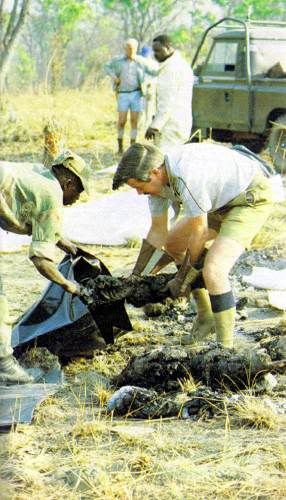
Joshua Nkomo, co leader of the Patriotic Front would later gloat that his men had shot down the aircraft, but he would deny that his terrorists were responsible for the massacre which followed. No one in his right mind believes him.

“Donga of Death” “Burnt, shattered monument to an act of satanic evil . . .the tail section of the
downed Viscount.”
In New York, ZAPU's representative at the United Nations, Dr Callistus Ndlovu, contradicted Nkomo by taking credit for the slaughter, claiming that the 10 survivors had been gunned down to show that the Kariba sector was a "war zone."
The civilised world — including the World Council of Churches, the United Nations and many politicians whose names are familiar to all of us saw the outrage differently. The atrocity was likened to the crimes against humanity committed by the Germans and Japanese during the Second world War. There were demands that the culprits be brought to justice, but there is no hope of that; certainly not in this world.
"THE execution of the crash survivors actually took place at 5.45 pm, about 30 minutes after the Viscount exploded in flames. It does, in fact, seem unlikely that the terrorists who shot the survivors were the same ones responsible for the destruction of the plane. Sam-7 missiles are launched on a visual sighting behind the target to seek out and chase the plane's hot exhaust gases with infra-red detectors.
Passengers estimate that only five minutes passed from the moment of impact to the time of the crash. It is not known how far the damaged Viscount flew while going in, but it must have been at least five or six miles. It is doubtful that the missile team could have covered that distance through thick bush in half an hour, although that may have been so.
It seems more likely, though, that another ZIPRA section operating in the area saw the flaming aircraft or sighted the pall of smoke and decided to investigate.
ALL of the survivors have only a hazy recollection of the crash, but the memory of the horror that followed will be seared on their minds for ever.
"I did what the pilot told us to do," says Salisbury dentist Dr Cecil McLaren. "I told Sharon (Mrs Cole, who was sitting next to him with her daughter Tracey) that the best thing we could do was to put our heads between our knees and hope for the best."
The plane hit with a shriek of tortured metal, then darkness and oblivion engulfed nearly everyone as the aircraft somersaulted and the world turned upside down.
The fuselage snapped in two, the rear section was tossed clear and the rest disintegrated -killing everyone in it. I landed upside down with my mouth full of earth," says
Rhodesia Howls For Revenge
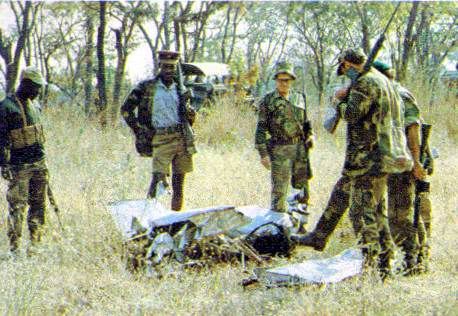
A small piece of un-burnt debris marks the spot of the aircraft's first impact.
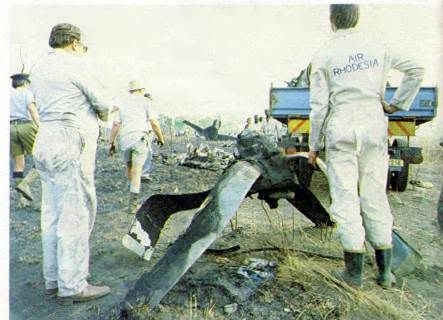
Air Rhodesia technicians preparing to haul away one of the Viscount's dismembered propellers.
At this stage, nobody realised the aircraft had been shot down by a terrorist missile.
Dr McLaren. "I saw daylight shining through a jagged tear in the fuselage, so I shouted to Sharon and Tracey to follow me and crawled through."
Honeymooners Shannon and Robert Hargreaves, escaped from the wreck the same way. In common with other survivors, their shoes had been ripped off in the crash.
AS other passengers climbed or were helped from the slowly burning tail section, Dr McLaren decided to go to a nearby village, visible from the crash site, and ask for help and water. Sharon Cole, four-year-old Tracey, as well as the Hargreaves couple went along too.
"When we got to the village there was nobody there," says Dr. McLaren. "Eventually a door opened, and then another. I asked a woman for water. We splashed our eyes and our faces and then went back to the plane. I remember seeing a young air hostess lying on the ground saying: 'Please, give me some water. Please.' Her upper arm was fractured."
The hostess's name was Dulcie Esterhuizen. She suffered the most horrifying torture of all.
After being forced to watch nine other survivors shot to death, she was repeatedly raped by members of the gang. An hour later they bayoneted her to death, laughing wildly as they did so.
When Dulcie had asked for water, Dr McLaren and his party of four returned to the village to fill a calabash for the others as well. The trip saved their lives. For while they were away the terrorists arrived, swaggering out of the bush, heavily armed and with gloating grins of triumph on their faces.
EVEN now the survivors can still hardly believe that the. nightmare actually happened; even now they find it difficult to comprehend the full ghastly horror of what they were forced to witness.
Survivor Hans Hansen, a Dane who has lived in Rhodesia for the past nine years, recalls: "It was a scene of absolute horror. It was the most savage and brutal act I have ever seen.
"I cannot accept that human beings could behave this way. People call them 'guerillas'... I would like to call them animals, but not even animals behave in such a manner."
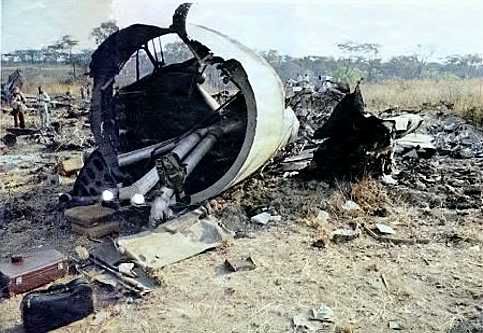
Remains of the rear fuselage section.
All 18 survivors were in this part of the aircraft.
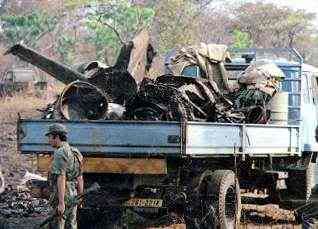
Once an airliner packed with happy holidaymakers
. . . now a pile of trash in the back of a lorry.
SAYS Diana Hansen: "We were searching the wreck when the terrorists arrived. They were all young, and obviously very excited. They were all carrying AK-47s.
"They said they would give us water and help, and some people started thanking them ..." At this stage of the interview, Mrs, Hansen broke down and wept, too distraught to continue.
Tony Hill takes up the story . . . "They herded the lot of us together and ordered the uninjured to carry those who couldn't walk. I remember there were some women and children and an old man who had trouble walking because he was suffering from arthritis..."
Diana Hansen suddenly cuts into the conversation: "We were all standing in a group when one of the terrorists said 'You have stolen our land.' I knew then that they were going to kill us."
AND then the leering terrorists opened up on the dazed and helpless survivors.
"They started firing and we ran for our lives towards a ridge," says Hans. "Tony Hill was with us, but the others were just shot down where they were.
"It was awful. We could hear them crying out over and over again: 'Please don't shoot us. Please don't shoot us.' But the terrorists just kept on firing."
Some of the injured passengers were still lying on the ground when the first burst of automatic fire cut into them. Others who tried to flee were shot to pieces within a few yards.
"They shot at us too," says Hans. "We heard the bullets buzzing past, but miraculously none of us was hit."
AS the trio reached a gully and dived into it, they heard a long burst of automatic fire as the gang of nine savages finished off the wounded.
But they did not kill Dulcie Esterhuizen. Not yet. She was a servant of the Rhodesian Government,. and she merited special treatment.
For an hour Tony Hill and the Hansens listened aghast to her screams of agony until her torment ended with a gasp of "Oh, my God," as the giggling terrorists finally bayoneted her to death.
DR. McLaren's group also managed to escape. As they approached the wreck after a fruitless search for water they heard the sound of gunfire and saw tracer bullets ripping through the branches above them.
"We thought the heat from the fire had caused some of the bullets in the aircraft to go off," says Robert Hargreaves. "But when I shouted for Tony Hill, who I knew was with the group near the plane, there was no reply. Then an African shouted 'Come here,' and I knew they were terrs.
Please Don't Shoot. Please Don't Shoot Us

Survivor Tony Hill.
A Premonition made him sit at the rear of the aircraft.

Captain John Hood ..
but for a cruel twist of fate he could have probably have got the Viscount down unscathed.
"They shot at us twice, and both times my wife and I hit the deck just in time. We got up after the shooting and ran. I ran faster than I have ever done in my life. I had injured my neck in the crash, but the pain didn't mean anything to me then ..."
By then it was nearly dark, and the third chapter in the nightmare experience of the pitiful band of survivors was about to begin. The group hid in a dry river bed for the long, freezing cold night, ears straining to catch the slightest sound ... the rustle ot footsteps through the grass, the dry snap of twigs breaking, the lonely hoot of an owl.
AND so the long night passed. Next morning, the area was alive with spotter aircraft and tracker teams continuing the search abandoned late the previous night.
A heavy ground haze hampered rescuers but by mid-day the crash site had been found and paramedics and men of the elite Special Air Services Regiment had parachuted in. Only then did the full extent of the most cold-blooded massacre by terrorists in the history of Rhodesia's six years of bloody war, become known.
That same morning the five survivors in Dr McLaren's group wandered through the bush until they came to what appeared to be a well-used track. They had only been there for a short while, when two vehicles came round the bend and their long ordeal had ended at last. They were taken to hospital in Karoi, physically none the worse for their experiences, but mentally scarred for life.
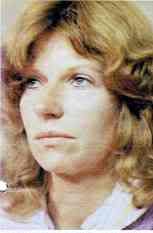
Diana Hansen..
They said they would give us water and help
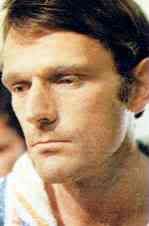
Hans Hansen..
It was the most savage and brutal act I have ever seen.
Tony Hill and the Hansens were picked up by army helicopters and whisked away for medical treatment in Kariba hospital. They too could only speak with stunned horror as they recounted their trial by terror.
AS truckloads of troops were ferried along the dangerous, dusty roads of the Urungwe tribal trust land and helicopters set down pursuit sticks of grim-faced soldiers with hatred burning in their hearts, the Rhodesian people howled for bloody vengeance against the creatures who had carried out the massacre.
Only one week later, 20 terrorists had been destroyed in the area, but at the time of going to press ballistic reports on the cartridges found next to the bodies of the victims had not been matched against the weapons carried by the dead men.
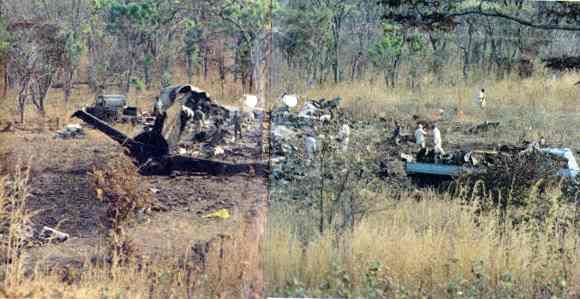
“General view of the crash site.
If the Viscount had not hit a donga in the middle of the field it may well have survived virtually intact.”
But if the Rhodesians have not yet killed every one of the gang, they will keep on looking until the last of them is wiped from the face of the earth. Of that you can be certain.

Back Cover of the Supplement
End of Article
Recompiled by Eddy Norris, from the Scope magazine dated September 22, 1978, for no or intended financial gain but rather to record the events that transpired in Rhodesia
Thanks are recorded to:-
The Publishers and Owners of Scope Magazine
Frank Bate and Francois Darquennes
Diarmid Smith for making the article available to ORAFs.
Paul Mroz for the image hosting sponsorship
Paul Norris for Internet sponsorship
Special thanks to Neill Jackson and Robb Ellis for their assistance.
Eddy Norris can be contacted direct on orafs11@gmail.com

An Act Of Disgusting Brutality
SUNDAY, September 3, (1978) 5.05 pm, Rhodesian time. Watched by heavily-armed members of the security forces, Air Rhodesia Viscount VP-WAS lifted off from Kariba Airport right on schedule.
Apart from a slight smoke haze on the ground, visibility was good as flight RH 825 climbed steeply at 160 knots on the way to its cruising height of 15 000 feet for the short routine hop to Salisbury.
On board were 52 passengers and four crew. Of the passengers on the Viscount 34 relaxed and happy holidaymakers men, women and children returning home - had less than 10 minutes to live.
Three of the crew would also die in flaming agony; the fourth - a lovely young air hostess - would live . . . only to be pack-raped, bayoneted and finally, and perhaps mercifully shot to death.
Seventeen other people would miraculously survive the first stage of the awful holocaust to come. But only eight would live to tell the full story of the horrendous aftermath, a story of unsurpassed, incomprehensible horror and bestiality that has shocked and stunned most of the civilised world.
IN the cockpit, Captain John Eric Courteney Hood, 36, set a heading of 160 degrees south- east as the aircraft sped along at three nautical miles a minute to its destination in Salisbury about 55 minutes away from take-off.
Rhodesian-born and educated at Allan Wilson Technical High School in Salisbury, Captain Hood had two daughters aged 10 and three by his first wife. Only recently, he had married for the second time.
Captain Hood was an extremely experienced pilot with about 8 000 flying hours in his logbook. Within the next few terrible minutes, all his years of experience and training, all his personal courage and daring, would be put to the ultimate test.
He would be called upon to land an aircraft blazing fiercely and breaking up in mid-air. He would have to do the impossible and. but for a cruel twist of fate, he would nearly succeed.
Also on the flight deck sat First Officer Garth George Beaumont, 31. Single, born in Florida in the Transvaal, but educated at Plumtree School in Matabeleland, he had joined Air Rhodesia in 1974 and was converted to Viscounts the same year. First Officer Beaumont, too, was a highly competent pilot who had notched up about 4 000 flying hours.
The type of aircraft the two men were flying is one of the most remarkable and reliable air- liners in service anywhere.
Powered by four Rolls-Royce Dart turbo-prop engines each delivering 1 600 horsepower, Viscounts were first delivered to what was then Central African Airways in 1956. During 22 years of non-stop service, they have become a legend to all who fly them. No other airline crews in the world are as experienced on Viscounts as Air Rhodesia staff.
IN the passenger section of the aircraft every seat was occupied. The Fasten Seat Belts and No Smoking signs had been switched off and passengers with window seats watched the magnificent panorama of Lake Kariba sparkling in the sunlight. Then the aircraft banked and headed south-east across the dense green bush of the terrorist- infested Urungwe tribal trust land.
For many of the people on board, a weekend at Kariba - Rhodesia's Riviera - was a chance to relax, to forget the daily grind of city life and put aside all thoughts of the bitter terror war which has already claimed more than 3 000 lives this year alone.
Air hostesses Brenda Pearson, 23, and Dulcie Esterhuizen, 21, walked down the aisle with a trolley of cocktails and sun-downers ordered before take-off. Some passengers chatter quietly to family and friends; others, exhausted after a hectic Kariba weekend, dozed peacefully in their seats; yet others gazed at the thick carpet of bush sliding below as the Viscount surged into the late afternoon sky.
SALISBURY tobacco farmer Tony Hill unclipped his seat belt and settled back as one of the pretty stewardesses poured him an ice-cold beer. Hill was feeling good. He had shrugged off the sudden, fleeting stab of uneasiness that had gripped him as he boarded the plane at Kariba ... the unaccountable twinge of apprehension that had made him choose a seat at the rear of the aircraft.
Now the feeling had gone, and Hill, who had been visiting friends at Kariba, turned his thoughts to Salisbury and home, where his wife Marcia and his daughters Brenda and Sonia would be waiting eagerly to greet him.
Tony Hill would have to endure hell on earth before he saw his family again.
In Salisbury, relatives and friends were preparing to drive out to Hatfield to meet the aircraft, which was scheduled to land at 6 pm. It never arrived.
ON the ground, about 20 miles from Kariba Airport, a shoulder-launched SAM-7 surface-to-air missile was primed ready to be fired.
Terrorists attached to Joshua Nkomo's Zimbabwe People's Revolutionary Army (ZIPRA) had set the weapon directly in line with the Viscount's flight path. They knew that Air Rhodesia sticks rigidly to its flight schedules. They knew that flight RH 825 would take off at 5:05 pm on Sunday, September 3. They also knew the aircraft would pass directly overhead. That was why they were there. Now they waited to blast it from the sky.
The Viscount was flying at between nine and 10 000 feet and still climbing when the Soviet-made warhead came streaking upwards on a cone of orange flame, homing in faster than the speed of sound on the heat from the aircraft's engine exhausts.
There was no escape, no evasive action Captain Hood could possibly have taken, even had he known what was about to strike. Once the missile rocketed from the launch tube, flight RH 825 was doomed.
With a blast that shook the entire aircraft, the missile tore into the inner starboard motor, causing a simultaneous explosive chain reaction in the outer engine as well.
FRIGHTENED passengers stared in dumbstruck horror as thick black smoke and long tongues of flame streamed past the cabin windows and chunks of debris spun away in the slipstream.
The aircraft shuddered like a mortally wounded bird, and at that moment Captain Hood and First Officer Beaumont, as well as most people on board, must have known that they were about to die. In the cabin, pandemonium broke out.
On the flight deck, all was calm but both men must have been bewildered by the suddenness with which disaster had struck. Years of constant training had equipped them to deal with any emergency likely to be encountered in the air, but no training manual yet devised lists the steps to be taken by an air- line pilot when his civilian aircraft is blasted by a heat-seeking missile. Neither Hood nor Beaumont could have had the slightest idea of what had really happened.
If the airflow over the wings and the forward position of the flight deck on a Viscount prevented Hood from seeing the flames billowing from the engines, the first warning he would have had of impending catastrophe was the flashing of amber warning lights and the strident clamour of bells on the instrument panel, indicating that engine numbers three and four were ablaze.
Fire in the air is a pilot's greatest nightmare, his constant over-riding fear.
Captain Hood knew that a Viscount can, in certain circumstances, fly comfortably on only two engines, But he must also have realised that to try to turn back to Kariba would have been fatal as he would have lost crucial airspeed in attempting the turn.
THE aircraft was in immediate danger of breaking apart in mid-air; it was a miracle that the fuel in the wing tanks had not already exploded and blown the ship to bits.
There was only one thing to do, one course of action to take: the Viscount had to be put down in the shortest possible time on the first stretch of open ground directly in its path.
All Captain Hood's experience and training must have told him that his was an impossible task. Yet he never gave up. The feelings of the two pilots will never be known. Both are dead. But one thing is certain, neither panicked for a moment; their conduct throughout was a credit to their profession.
When the missile struck and the fire alarms went, Hood and Beaumont carried out the routine drills each could have done blindfolded. Shut down all systems on engines three and four . . . close off high pressure cocks and fuel lines; feather both props, set stop watch and fire first extinguisher. .. wait 45 seconds . . . shoot the second fire bottle, flaps down to reduce airspeed during the descent, no time to drop the undercarriage to create more drag and slow the aircraft.
"And look for somewhere — And look for somewhere."

Satan's handiwork .. . grim-faced Rhodesian trooper stares in horror at the charred remains of passengers who died when an Air Rhodesia Viscount was brought down by a terrorist SAM-7 missile.
EVERYTHING was happening at once, yet Captain Hood still had the presence of mind during this critical time to not only radio a distress signal to Kariba flight control, but to reach down, change his transmission switch in public address and speak to his passengers as well.
At about 5,10 pm - only a scant five minutes after take-off and about 20 miles from the Kariba airstrip - Captain Hood transmitted his last message to the world out-side his maimed aircraft. Some of it was garbled, bul a National Parks Board pilot tunes into VP-WACs radio frequency picked up these words: "I can't . , . the engines are going like f . . , Help me? I have lost both starboard engines... Were going in."
Then Captain Hood switched to internal PA - still holding the aircraft in a steep dive and battling to keep it on an even keel — and spoke to his passengers. He instructed them lo fasten their seat belts, keep calm, and to place their heads in the "crash position" between their knees.
"We are going in for an emergency landing.
IN the main compartment passengers sat in stunned horror. Here and there a woman sobbed and screamed and some men milled around in panic-stricken confusion. Sheets ol flame shot past the windows, the intense heat searing the metal fuselage.
One man ran down the aisle shouting for a fire extinguisher, another tried to force open the emergency exit and jump out as the plane plummeted earthwards, its two engines wailing like banshees.
A Viscount normally lands at a speed of 95 knots, but airspeed must have built up way beyond that mark during the emergency descent. It was unavoidable. he aircraft had to be put down and the passengers evacuated within minutes.
Captain Hood decided to doa wheels-up belly landing on a roughly ploughed cotton field the size of two football pitches in the rocky foothills of the rugged Whamira Hills, about 50 miles due west of Karoi. Ironically, Whamira is Shona for "You can't go any further."
As he brought the aircraft in low, its propellers scything through tree tops, death stared both Hood and Beaumont in the face. Yet even then. Hood still had the ice-cool courage to warn his passengers: "Brace for impact!" They were the last words ever spoke.
HE nearly made it," says Chief Inspector Mike Farrell, the Rhodesian police officer in command of the crash zone.

The Blood Of Innocents Is On His Hands

This is what your brave "Freedom Fighters" did Mr. Nkomo.
You must be very proud of them

A terrible task A BSA policeman loads a fire blackened body into a plastic bag for later identification.
"He came in over those trees he adds, pointing to the edge of the clearing. "You can see where he took the tops off. It was quite a feat of flying to find this clear space, and we believe the plane was coming down well under control. If he hadn't hit the donga wall he might have pulled it off."
The field is split by a gully about 15 feet wide and 20 feet deep in parts, the earth bank freshly scarred where the aircraft slammed into it after skidding down the sloping field or its belly for about 100 yards.
THE whole area is littered with crash debris; chunks twisted scrap, fire blackened engines, a buckled propeller lying on the donga bank, pools of molten metal liquefied by the searing flames, the surrounding bush scorched by the bushfire sparked off by ruptured fuel tanks as the Viscount cart wheeled across the donga and exploded in a ball of fire.
Cameras, shoes, suitcases, a child's doll, a bloodstained petticoat, a tennis racket, charred playing cards, scraps of torn clothing ... all pathetic reminders of the awful human tragedy played out in this remote and lonely spot.
In the forward section of the cabin are the cinder-black corpses of some of the passengers and crew killed on impact, their bodies still doubled over in the crash position. Burnt limbs and carbonised skulls are scattered in heaps of ash, and the soft breeze still bears the bitter-sweet reek of charred flesh.
White-overalled aviation experts sift through the wreckage seeking to identify the cause of the disaster - at this early stage it was not known that the Viscount had been brought down by a missile — and BSA police- men wearing rubber gloves picks through the grisly debris for scraps of burnt flesh, arms, legs, skulls, mutilated and scorched bodies which they place in plastic bags. All the dead were taken to Salisbury tor identification.
The only recognisable section of the downed aircraft is the tail plane and the rear section of the fuselage which held the last five rows of seats. All 18 survivors were sitting there.
THEIRS was a truly miraculous escape from death. But when they stumbled from the wreckage, many of them torn and bleeding, all of them dazed and shocked, their ordeal had only just begun.
Only eight would live, the others would be butchered in cold blood in a deed so disgusting and inhuman that the sane mind struggles to understand it. shies away from the satanic enormity of the crime.

Joshua Nkomo, co leader of the Patriotic Front would later gloat that his men had shot down the aircraft, but he would deny that his terrorists were responsible for the massacre which followed. No one in his right mind believes him.

“Donga of Death” “Burnt, shattered monument to an act of satanic evil . . .the tail section of the
downed Viscount.”
In New York, ZAPU's representative at the United Nations, Dr Callistus Ndlovu, contradicted Nkomo by taking credit for the slaughter, claiming that the 10 survivors had been gunned down to show that the Kariba sector was a "war zone."
The civilised world — including the World Council of Churches, the United Nations and many politicians whose names are familiar to all of us saw the outrage differently. The atrocity was likened to the crimes against humanity committed by the Germans and Japanese during the Second world War. There were demands that the culprits be brought to justice, but there is no hope of that; certainly not in this world.
"THE execution of the crash survivors actually took place at 5.45 pm, about 30 minutes after the Viscount exploded in flames. It does, in fact, seem unlikely that the terrorists who shot the survivors were the same ones responsible for the destruction of the plane. Sam-7 missiles are launched on a visual sighting behind the target to seek out and chase the plane's hot exhaust gases with infra-red detectors.
Passengers estimate that only five minutes passed from the moment of impact to the time of the crash. It is not known how far the damaged Viscount flew while going in, but it must have been at least five or six miles. It is doubtful that the missile team could have covered that distance through thick bush in half an hour, although that may have been so.
It seems more likely, though, that another ZIPRA section operating in the area saw the flaming aircraft or sighted the pall of smoke and decided to investigate.
ALL of the survivors have only a hazy recollection of the crash, but the memory of the horror that followed will be seared on their minds for ever.
"I did what the pilot told us to do," says Salisbury dentist Dr Cecil McLaren. "I told Sharon (Mrs Cole, who was sitting next to him with her daughter Tracey) that the best thing we could do was to put our heads between our knees and hope for the best."
The plane hit with a shriek of tortured metal, then darkness and oblivion engulfed nearly everyone as the aircraft somersaulted and the world turned upside down.
The fuselage snapped in two, the rear section was tossed clear and the rest disintegrated -killing everyone in it. I landed upside down with my mouth full of earth," says
Rhodesia Howls For Revenge

A small piece of un-burnt debris marks the spot of the aircraft's first impact.

Air Rhodesia technicians preparing to haul away one of the Viscount's dismembered propellers.
At this stage, nobody realised the aircraft had been shot down by a terrorist missile.
Dr McLaren. "I saw daylight shining through a jagged tear in the fuselage, so I shouted to Sharon and Tracey to follow me and crawled through."
Honeymooners Shannon and Robert Hargreaves, escaped from the wreck the same way. In common with other survivors, their shoes had been ripped off in the crash.
AS other passengers climbed or were helped from the slowly burning tail section, Dr McLaren decided to go to a nearby village, visible from the crash site, and ask for help and water. Sharon Cole, four-year-old Tracey, as well as the Hargreaves couple went along too.
"When we got to the village there was nobody there," says Dr. McLaren. "Eventually a door opened, and then another. I asked a woman for water. We splashed our eyes and our faces and then went back to the plane. I remember seeing a young air hostess lying on the ground saying: 'Please, give me some water. Please.' Her upper arm was fractured."
The hostess's name was Dulcie Esterhuizen. She suffered the most horrifying torture of all.
After being forced to watch nine other survivors shot to death, she was repeatedly raped by members of the gang. An hour later they bayoneted her to death, laughing wildly as they did so.
When Dulcie had asked for water, Dr McLaren and his party of four returned to the village to fill a calabash for the others as well. The trip saved their lives. For while they were away the terrorists arrived, swaggering out of the bush, heavily armed and with gloating grins of triumph on their faces.
EVEN now the survivors can still hardly believe that the. nightmare actually happened; even now they find it difficult to comprehend the full ghastly horror of what they were forced to witness.
Survivor Hans Hansen, a Dane who has lived in Rhodesia for the past nine years, recalls: "It was a scene of absolute horror. It was the most savage and brutal act I have ever seen.
"I cannot accept that human beings could behave this way. People call them 'guerillas'... I would like to call them animals, but not even animals behave in such a manner."
Hansen, 35 escaped with his newly wed wife Diana 31, and farmer Tony Hill while the other survivors were being executed by the terrorists.
Hill, who escaped from the wreckage by tearing at a crack in the fuselage with his bare hands, says: "Hans and Diana followed me through the gap, and then we went back in and dragged out the other survivors. We put them down away from the burning tail section and then went back to look for blankets and warm clothing.

Remains of the rear fuselage section.
All 18 survivors were in this part of the aircraft.

Once an airliner packed with happy holidaymakers
. . . now a pile of trash in the back of a lorry.
SAYS Diana Hansen: "We were searching the wreck when the terrorists arrived. They were all young, and obviously very excited. They were all carrying AK-47s.
"They said they would give us water and help, and some people started thanking them ..." At this stage of the interview, Mrs, Hansen broke down and wept, too distraught to continue.
Tony Hill takes up the story . . . "They herded the lot of us together and ordered the uninjured to carry those who couldn't walk. I remember there were some women and children and an old man who had trouble walking because he was suffering from arthritis..."
Diana Hansen suddenly cuts into the conversation: "We were all standing in a group when one of the terrorists said 'You have stolen our land.' I knew then that they were going to kill us."
AND then the leering terrorists opened up on the dazed and helpless survivors.
"They started firing and we ran for our lives towards a ridge," says Hans. "Tony Hill was with us, but the others were just shot down where they were.
"It was awful. We could hear them crying out over and over again: 'Please don't shoot us. Please don't shoot us.' But the terrorists just kept on firing."
Some of the injured passengers were still lying on the ground when the first burst of automatic fire cut into them. Others who tried to flee were shot to pieces within a few yards.
"They shot at us too," says Hans. "We heard the bullets buzzing past, but miraculously none of us was hit."
AS the trio reached a gully and dived into it, they heard a long burst of automatic fire as the gang of nine savages finished off the wounded.
But they did not kill Dulcie Esterhuizen. Not yet. She was a servant of the Rhodesian Government,. and she merited special treatment.
For an hour Tony Hill and the Hansens listened aghast to her screams of agony until her torment ended with a gasp of "Oh, my God," as the giggling terrorists finally bayoneted her to death.
DR. McLaren's group also managed to escape. As they approached the wreck after a fruitless search for water they heard the sound of gunfire and saw tracer bullets ripping through the branches above them.
"We thought the heat from the fire had caused some of the bullets in the aircraft to go off," says Robert Hargreaves. "But when I shouted for Tony Hill, who I knew was with the group near the plane, there was no reply. Then an African shouted 'Come here,' and I knew they were terrs.
Please Don't Shoot. Please Don't Shoot Us

Survivor Tony Hill.
A Premonition made him sit at the rear of the aircraft.

Captain John Hood ..
but for a cruel twist of fate he could have probably have got the Viscount down unscathed.
"They shot at us twice, and both times my wife and I hit the deck just in time. We got up after the shooting and ran. I ran faster than I have ever done in my life. I had injured my neck in the crash, but the pain didn't mean anything to me then ..."
By then it was nearly dark, and the third chapter in the nightmare experience of the pitiful band of survivors was about to begin. The group hid in a dry river bed for the long, freezing cold night, ears straining to catch the slightest sound ... the rustle ot footsteps through the grass, the dry snap of twigs breaking, the lonely hoot of an owl.
AND so the long night passed. Next morning, the area was alive with spotter aircraft and tracker teams continuing the search abandoned late the previous night.
A heavy ground haze hampered rescuers but by mid-day the crash site had been found and paramedics and men of the elite Special Air Services Regiment had parachuted in. Only then did the full extent of the most cold-blooded massacre by terrorists in the history of Rhodesia's six years of bloody war, become known.
That same morning the five survivors in Dr McLaren's group wandered through the bush until they came to what appeared to be a well-used track. They had only been there for a short while, when two vehicles came round the bend and their long ordeal had ended at last. They were taken to hospital in Karoi, physically none the worse for their experiences, but mentally scarred for life.

Diana Hansen..
They said they would give us water and help

Hans Hansen..
It was the most savage and brutal act I have ever seen.
Tony Hill and the Hansens were picked up by army helicopters and whisked away for medical treatment in Kariba hospital. They too could only speak with stunned horror as they recounted their trial by terror.
AS truckloads of troops were ferried along the dangerous, dusty roads of the Urungwe tribal trust land and helicopters set down pursuit sticks of grim-faced soldiers with hatred burning in their hearts, the Rhodesian people howled for bloody vengeance against the creatures who had carried out the massacre.
Only one week later, 20 terrorists had been destroyed in the area, but at the time of going to press ballistic reports on the cartridges found next to the bodies of the victims had not been matched against the weapons carried by the dead men.

“General view of the crash site.
If the Viscount had not hit a donga in the middle of the field it may well have survived virtually intact.”
But if the Rhodesians have not yet killed every one of the gang, they will keep on looking until the last of them is wiped from the face of the earth. Of that you can be certain.

Back Cover of the Supplement
End of Article
Recompiled by Eddy Norris, from the Scope magazine dated September 22, 1978, for no or intended financial gain but rather to record the events that transpired in Rhodesia
Thanks are recorded to:-
The Publishers and Owners of Scope Magazine
Frank Bate and Francois Darquennes
Diarmid Smith for making the article available to ORAFs.
Paul Mroz for the image hosting sponsorship
Paul Norris for Internet sponsorship
Special thanks to Neill Jackson and Robb Ellis for their assistance.
Eddy Norris can be contacted direct on orafs11@gmail.com


16 Comments:
This comment has been removed by the author.
Un freaken believable! These poor poor folk. We had such an amazing country and so many of our friends died..for what? For Mugabe to inherit by a rigged election only to destroy and continue 30 years later to blame the whites. How sad is Africa..how pathetic is the metality. Long live these poor people. Long live Rhodesia!RIP.Lest we forget.
I remember this so well. Ant Hill was an acquaintance of ours. I have to say, this tragic event was one of the reasons we left all those years ago. It still makes me sick to my stomach.
Thanks Eddy, and ORAFs, for having the guts to tell it all, as it should be, for the the truth to set everyone free. At the going down of the sun, and in the morning, we will remember them.
Prop Geldenhuys, Durban.
I had buried this memory but now I feel sick all over again.
I used to play tennis at Glen Clova (40 miles east of Fort Vic) with Ima Hood who was John Hood's mother.
My BSAP shamwari, Patrol Officer Malcolm Gillespie, with whom I sometimes bunked at Cranbourn when I was on R&R from Mount Darwin, and his fiancee, Woman Patrol Officer Dawn Young, were killed instantly in the Viscount Hunyani atrocity. Thanks for keeping memories of the victims alive... not for us the "Deafening Silence".
Thank you for reminding us of those dark days and that primitive act of barbarism
Thanks Eddy. Great to have the whole text there which I have been unable to get before. It must be kept in mind that some facts are inaccurate it was a hastily written story . The main one was that counts is that there was no rape. Some small comfort for the families of those involved.
Two websites that provide more info
http://home.iprimus.com.au/rob_rickards/viscounts/viscounts.htm
http://www.viscountdown.com/
The Viscount Hunjani atrocity, is the worst example of satanic bestiality I have ever known about, in my entire life. Shamefully, the British Foreign Secretary, David Owen remained silent,and not one word of condemnation came out of his mouth, as with his superior, the despicable Labour Prime Minister, James Callaghan. In less than two years, Rhodesia was sold down the road by a Conservative Government, under the equally despicable Thatcher and her little weazle, Carrington. I hope the sub-human filth who carried out this indescribable act of evil, burn in hell. Rhodesia will always live forever in my heart. Al The Rhodie
According to Karin Pretorious, a friend of ours at the time and who stayed with us in Kariba before and after this horrific event was adamant rape did not take place but the editor of Scope magazine insisted that a rape story be added to make the story more sensational. On her return visit to Kariba and staying with us again, she told us that she kept repeating to the editor "there was no rape...I'm telling you there was no rape" but he nevertheless insisted it be added to the story. I think Karen Resigned after that because she gave us her camera.which I still have and use.
Dulcie Esterhuizen was my aunt , our family still talks about this tragedy
Ive got doctors certificates that there were no rapes.
One of the worst days of my life. Waiting for news most of the night. Then a second one, we wondered if we were next.
Betty Cockbill (Cole) One of the worst days of my life. Waiting for news most of the night. then a second one and we all wondered if we were next.
I'm trying to connect with all survivors (esp. Dr Cecil McLaren) from the Hunan Flight 825 disaster. If anyone has details I'd really appreciate it. Jamie Anders (Ex Rhodie)
Hey there nice blog nice information provide by this
Examination Trolley
Post a Comment
Subscribe to Post Comments [Atom]
<< Home